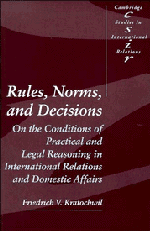 Rules, Norms, and Decisions
Rules, Norms, and Decisions Published online by Cambridge University Press: 01 June 2011
With the demonstration of the special nature of reasoning with rules employed in the third-party mode, the systematic exposition of my argument concerning rules and norms has come to an end. This exposition began in chapter 3, after the evaluation of the regime approach had shown certain shortcomings in the conventional treatment and understanding of the function of norms. By utilizing a rather unorthodox methodology which I justified in chapter 1, I began with the examination of the function of norms, i.e., their problem-solving capacity, and their emergence. The following chapters were then devoted to the clarification of the role of norms in various contexts and, in particular, to their capacity for resolving conflict in a nonviolent fashion by structuring a discourse on grievances.
A more refined conceptual apparatus derived from speech-act theory and the communicative action approach enabled us to transcend some of the conventional pitfalls of regime-analysis, which explains norm-following in terms of the “long-term” interest of the actors and in terms of the “injunctions” regimes provide. As the discussion in chapter 5 demonstrated, aside from the very special circumstances of iterative PD games in tournament approaches, the (rule-)utilitarian argument becomes inconsistent.
Furthermore, the emphasis on claims and claiming opened the way for the analysis of one particularly important set of norms: rights, by which we decide the appropriateness and priority of conflicting claims. The discussion of chapter 6 dealt with the concept of right in an historical as well an analytical fashion.
To save this book to your Kindle, first ensure [email protected] is added to your Approved Personal Document E-mail List under your Personal Document Settings on the Manage Your Content and Devices page of your Amazon account. Then enter the ‘name’ part of your Kindle email address below. Find out more about saving to your Kindle.
Note you can select to save to either the @free.kindle.com or @kindle.com variations. ‘@free.kindle.com’ emails are free but can only be saved to your device when it is connected to wi-fi. ‘@kindle.com’ emails can be delivered even when you are not connected to wi-fi, but note that service fees apply.
Find out more about the Kindle Personal Document Service.
To save content items to your account, please confirm that you agree to abide by our usage policies. If this is the first time you use this feature, you will be asked to authorise Cambridge Core to connect with your account. Find out more about saving content to Dropbox.
To save content items to your account, please confirm that you agree to abide by our usage policies. If this is the first time you use this feature, you will be asked to authorise Cambridge Core to connect with your account. Find out more about saving content to Google Drive.